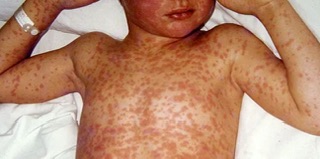
Meanwhile, late last year the state of Colorado had a confirmed case of measles for the first time since 2019.
Public health experts immediately sounded the alarm and are working to prevent a large outbreak since measles is so infectious.
The infected patient, whom health officials described as “an adolescent,” traveled through Denver International Airport on Dec. 13 and may have been infectious while attending a large gathering in Colorado Springs and later while visiting Children’s Hospital Colorado in Aurora on Dec. 18, according to experts at the Colorado Department of Public Health and Environment (CDPHE).
35 measles cases reported in 15 US states
Measles cases have been popping up around the country amid dropping rates of vaccination. The national vaccination average for kindergarteners has dropped approximately two percentage points since before the pandemic.
The Centers for Disease Control and Prevention reported 35 total cases this year in 15 states as of Feb. 22:
According to Mayo Clinic, measles is a childhood infection caused by a virus. Once quite common, measles can now almost always be prevented with a vaccine.
Also called rubeola, measles spreads easily and can be serious and even fatal for small children. While death rates have been falling worldwide as more children receive the measles vaccine, the disease still kills more than 200,000 people a year, mostly children.
As a result of high vaccination rates in general, measles hasn't been widespread in the United States for about two decades. Most recent measles cases in the U.S. originated outside the country and occurred in people who were unvaccinated or who didn't know whether or not they had been vaccinated.
Measles causes a red, blotchy rash that usually appears first on the face and behind the ears, then spreads downward to the chest and back and finally to the feet.
Symptoms
Measles signs and symptoms appear around 10 to 14 days after exposure to the virus. Signs and symptoms of measles typically include:
- Fever
- Dry cough
- Runny nose
- Sore throat
- Inflamed eyes (conjunctivitis)
- Tiny white spots with bluish-white centers on a red background are found inside the mouth on the inner lining of the cheek — also called Koplik's spots
- A skin rash made up of large, flat blotches that often flow into one another
The infection occurs in stages over 2 to 3 weeks.
- Infection and incubation. For the first 10 to 14 days after infection, the measles virus spreads in the body. There are no signs or symptoms of measles during this time.
- Nonspecific signs and symptoms. Measles typically begins with a mild to moderate fever, often with a persistent cough, a runny nose, inflamed eyes (conjunctivitis), and a sore throat. This relatively mild illness may last 2 to 3 days.
-
Acute illness and rash. The rash is made up of small red spots, some of which are slightly raised. Spots and bumps in tight clusters give the skin a splotchy red appearance. The face breaks out first.
Over the next few days, the rash spreads down the arms, chest, and back, then over the thighs, lower legs, and feet. At the same time, the fever rises sharply, often as high as 104 to 105.8 F (40 to 41 C).
- Recovery. The measles rash may last about seven days. The rash gradually fades first from the face and last from the thighs and feet. As other symptoms of the illness go away, the cough and darkening or peeling of the skin where the rash was may stay for about 10 days.
When can a person spread the measles virus?
A person with measles can spread the virus to others for about eight days, starting four days before the rash appears and ending when the rash has been present for four days.